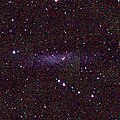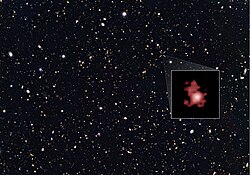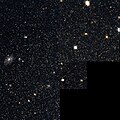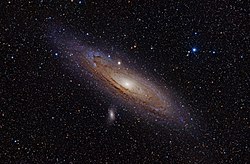List of galaxies
List of galaxies and galaxy clusters. Because there are so many galaxies in the universe, this list has been divided into several categories.
The first catalog that catalogues galaxies is the Catalogue of Galaxies and of Clusters of Galaxies.
List of nearby galaxies
This is list of nearby galaxies to the Milky Way Galaxy, our galaxy. The first four listed below are part of the Local Group of galaxies, a galaxy group containing at least 50 galaxies, including the Milky Way and Andromeda.
| Image | Name | Distance | Information |
|---|---|---|---|

|
Large Magellanic Cloud | 162,980 light years | This is a galaxy satellite of our Milky Way, and the prototype for the class "Magellanic type spiral". |

|
Small Magellanic Cloud | 200,000 light years | This is a galaxy satellite of our Milky Way. |

|
Andromeda Galaxy | 2,500,000 light years | Largest galaxy in the Local Group |

|
Triangulum Galaxy | 3,000,000 light years | Second nearest large galaxy to the Milky Way; Third largest galaxy in the Local Group. |

|
NGC 3109 | 4,340,000 light years | On the outskirts of the Local Group; may be a Magellanic type spiral . |

|
NGC 300 | 6,000,000 light years | Between the Sculptor Group and the Local Group; might form a gravitationally bound pair with NGC 55 (see below). |

|
NGC 55 | 6,500,300 light years | Might form a gravitationally bound pair with NGC 300 (see above) |
List of farthest galaxies
This is list of farthest galaxy from Milky Way. Remember, the farther away from a galaxy, the greater the redshift of galaxy. Redshift is when objects appear in a red color because they move away from us.
Note that the idea that the radius of the observable universe must amount to only 13.8 billion light-years (like the age of universe) is incorrect. Light travel distance (LTD) is time required for light to reach the observer.
(≈) means "almost equal to."
| Image | Name | Distance | Redshift |
|---|---|---|---|

|
GN-z11 | ≈ 32 billion light years (proper distance)
≈ 13.8 billion light years (light travel distance) |
z = 10.6 |

|
EGSY8p7 | 13.2 billion light years (light travel distance) | z = 8.68 |

|
EGS-zs8-1 | 13.04 billion light years (light travel distance) | z = 7.73 |
And other galaxies :
- Abell 1835 IR1916
- Andromeda I
- Andromeda II
- Andromeda III
- Andromeda XIX
- Baby boom galaxy
- Black Eye galaxy (M64)
- Bode's galaxy (M81)
- Canis Major dwarf galaxy
- Cartwheel galaxy
- Centaurus A galaxy (NGC 5128)
- Circinus galaxy
- Cigar galaxy (M82)
- Hoag's object (a ring galaxy)
- IC 10
- IC 1101 (Largest known galaxy with about 100 trillion stars)
- IC 1613
- Large Magellanic Cloud
- Leo I
- Leo II
- LGS 3
- Messier 49 (NGC 4472)
- Messier 83 (Southern Pinwheel galaxy)
- Messier 84 (NGC 4374)
- Messier 87 (NGC 4486)
- Messier 100 (NGC 4321)
- NGC 185
- NGC 147
- NGC 205 (M110)
- NGS 221 (M32)
- NGC 4526
- NGC 6822 (Barnard's Galaxy)
- Pinwheel galaxy (M101)
- Small Magellanic Cloud
- Sombrero galaxy (M104) Named “Sombrero” because it looks like a sombrero.
- Spindle galaxy (M102)
- Starfish galaxy- This is actually 2 Galaxies near the end of a merger.
- Sunflower galaxy (M63)
- Triangulum galaxy (M33)
- Whirlpool galaxy (M51) (Grand Design spiral galaxy)
- Wolf-Lundmark-Melotte (WLM)
- NGC 6872 (Condor Galaxy)
- Malin 1 (The largest known spiral or barred spiral galaxy)
- Segue 2 (One of the smallest known galaxies with only 1,000 stars.)
- UGC 12158 (A Milky Way twin)
- Fireworks Galaxy (NGC 6946)
- NGC 6744 (Somewhat like the Milky Way)
- NGC 1365 (The Great barred spiral galaxy)
- NGC 1232 (A large intermediate spiral galaxy (A galaxy that is a bit of a normal spiral galaxy, but is also a bit of a barred spiral galaxy)
- NGC 1316 (Fornax A)
- Rubin’s Galaxy (UGC 2885)
- NGC 4889 (Coma B)
- NGC 4874 (Coma A)
- NGC 4921 (An “anemic” spiral)
- Messier 74 (Phantom Galaxy)
- NGC 3310
- NGC 1566 (The Spanish Dancer)
- NGC 7603
- NGC 7603 b
- NGC 2403 (Galaxy a bit like the Triangulum Galaxy)
- NGC 6786 (Galaxy interacting with LEDA 62867)
- NGC 4911 (Spiral galaxy near the central region of the Coma Cluster.)
- NGC 6744 A (Satellite of NGC 6744 (See Above)
- NGC 1232 A (Satellite of NGC 1232 (See Above)
- NGC 1672 (Galaxy with a large bar, around 20 Kiloparsecs across.)
- Comet Galaxy ( Named after its unusual appearance due to it interacting with its home cluster.)
- Abell 2261-BCG (A large Galaxy)
- NGC 3982 (Classic Spiral galaxy)
- NGC 1073 (Somewhat like the Milky Way in type)
- NGC 3314 a (Overlaps NGC 3314 b (See below)
- NGC 3314 b (Overlapped by NGC 3314 a (See above)
- Messier 85 HCC1 [Densest Galaxy Known as of 2015 , near Messier 85.)
- Messier 59 (Elliptical Galaxy in the Virgo Cluster)
- Messier 99 (Coma Pinwheel Galaxy)
- Messier 88
- Messier 106 (A seyfert galaxy)
- NGC 5195 (Galaxy interacting with the Whirlpool Galaxy ( See above )
- Messier 109
- NGC 4490 (Interacting with NGC 4485 (See Below)
- NGC 4485 (Interacting with NGC 4495 (See Below)
- IC 4970-(Galaxy interacting with NGC 6872, stretching its arms.(See above)
List Of Galaxies Media
Related pages
- List of nearest galaxies
- Most distant things
- Local Group
- IC 1101: the largest known galaxy, with about 100 trillion stars.[1][2]
- Galaxy
- NGC
- Messier catalogue
References
- ↑ https://arxiv.org/PS_cache/astro-ph/pdf/0209/0209205v2.pdf
- ↑ Uson, Juan M.; et al. (1990). "The central galaxy in Abell 2029 – an old supergiant". Science. 250 (4980): 539–540. Bibcode:1990Sci...250..539U. doi:10.1126/science.250.4980.539. PMID 17751483. S2CID 23362384.




